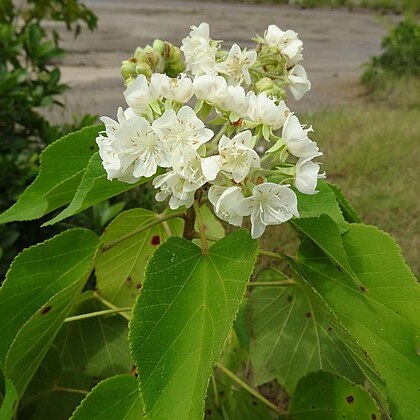Leaf-lamina up to 13 × 10 cm., ovate, usually unlobed, rarely shallowly 3-lobed, apex acuminate, cordate at the base, margin irregularly crenate-serrate, base cordate and 5 (7)-nerved, thinly scaberulous-pubescent above, softly and rather thinly pubescent below, nerves fairly prominent below; petiole up to 5·5 cm. long, densely pubescent or glabrescent; stipules c. 5 mm. long, very caducous, subulate, tomentose.
Flowers white, in many-flowered axillary panicles; peduncles slender, densely pubescent with both long and short stellate hairs; pedicels up to c. 2 cm. long, with similar indumentum; bracts c. 4 mm. long, very caducous, linear-lanceolate, densely pubescent.
Shrub, up to 5 m high. Leaves ovate, 40-120 x 3-11 mm. Pubescence on pedicels and peduncles mostly stellate-tomentose, intermixed with long (up to 1.5 mm), thin, acute spreading hairs. Petals 8-10 mm long. Flowers white, turning light brown with age.
Much-branched shrub or small tree up to c. 9 m. tall; young branches tomentellous or densely pubescent, dark brown and glabrescent later; bark smooth and light grey.
Ovary depressed-globose, tomentose; loculi glabrous inside; ovules 2 (3) per loculus; style 2 mm. long, glabrous; stigmas 3, recurved.
Seeds c. 3 × 2 mm., dark brown, usually 1 per loculus, obovoid; testa almost smooth or very minutely reticulate.
Stamens united below for c. 1 mm.; staminodes c. 6 mm. long, narrowly linear, glabrous.
Calyx-lobes c. 7 × 1·5 mm., narrowly lanceolate-acuminate, tomentellous outside.
Capsule c. 5 mm. in diam., depressed-globose, somewhat 3-lobed, tomentose.
Petals c. 1 × 0·6 cm., very obliquely cuneate.

